Dlink DSL-2890AL Manual
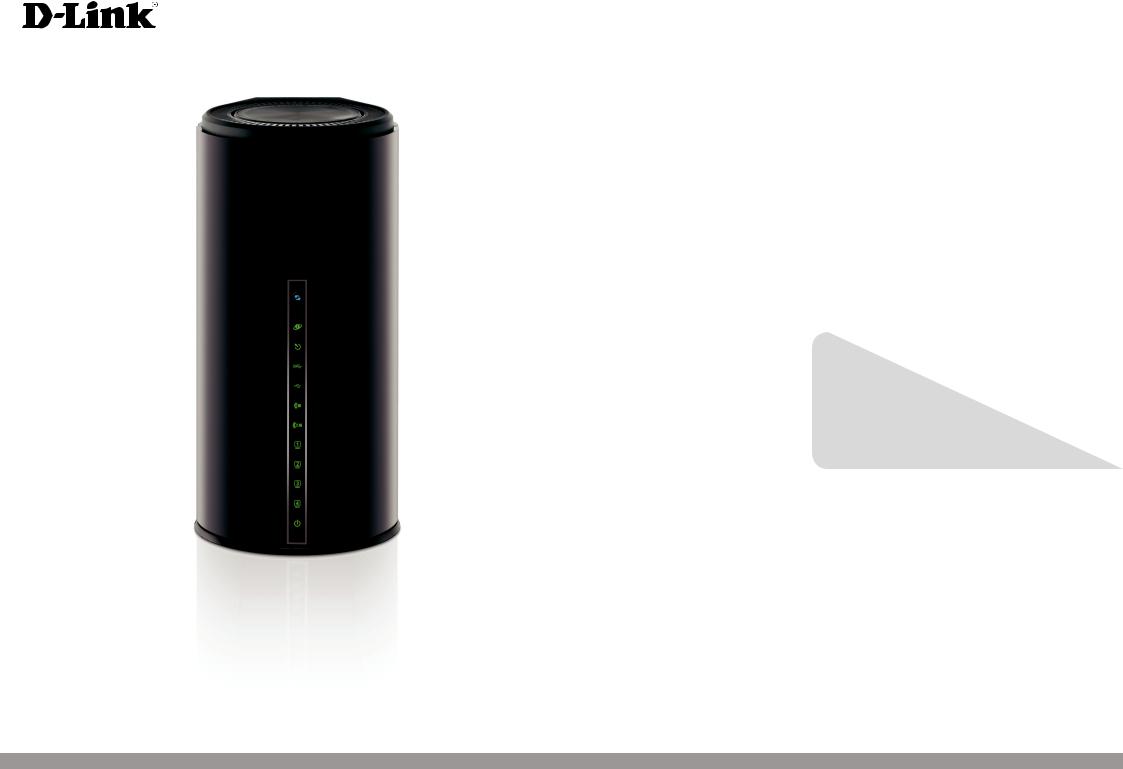
Version 2.0 | 03/19/2014
User Manual
Dual Band AC1750 Gigabit ADSL2+ Modem Router
DSL-2890AL

Dual Band AC1750 Gigabit ADSL2+ Modem Router User Manual
Table of Contents
Table of Contents................................................................................................... |
2 |
Product Overview................................................................................................... |
3 |
Package Contents ................................................................................................ |
3 |
System Requirements .......................................................................................... |
3 |
Features................................................................................................................ |
4 |
Hardware Overview .............................................................................................. |
5 |
Front Panel ....................................................................................................... |
5 |
Rear Panel ........................................................................................................ |
6 |
Bottom Panel .................................................................................................... |
7 |
Basic Installation.................................................................................................... |
8 |
Before You Begin ................................................................................................. |
8 |
Installation Notes .................................................................................................. |
8 |
Information needed from ADSL service provider............................................ |
10 |
Information needed about this Router ............................................................ |
11 |
Information needed about your LAN or computer .......................................... |
11 |
Device Installation .............................................................................................. |
12 |
Power on Router ............................................................................................. |
12 |
Factory Reset Button ...................................................................................... |
12 |
Network Connections...................................................................................... |
13 |
Getting Started ................................................................................................... |
14 |
How to connect to the Web User Interface..................................................... |
14 |
First Time Installation...................................................................................... |
15 |
Web User Interface Configuration...................................................................... |
22 |
Setup Category................................................................................................... |
23 |
Internet............................................................................................................ |
24 |
Wireless Settings ............................................................................................ |
40 |
Network Settings............................................................................................. |
56 |
Storage ........................................................................................................... |
59 |
Media Server................................................................................................... |
66 |
IPv6................................................................................................................. |
68 |
mydlink™ Settings .......................................................................................... |
94 |
Advanced Category ............................................................................................ |
98 |
Virtual Server .................................................................................................. |
99 |
Port Forwarding ............................................................................................ |
101 |
Port Triggering .............................................................................................. |
103 |
QoS Engine................................................................................................... |
105 |
Network Filter................................................................................................ |
108 |
Access Control.............................................................................................. |
110 |
Website Filter ................................................................................................ |
116 |
Inbound Filter ................................................................................................ |
117 |
Firewall Settings............................................................................................ |
119 |
Routing.......................................................................................................... |
122 |
Advanced Wireless ....................................................................................... |
123 |
Wi-Fi Protected Setup................................................................................... |
125 |
Advanced Network........................................................................................ |
130 |
Guest Wi-Fi ................................................................................................... |
132 |
IPv6 Firewall ................................................................................................. |
141 |
IPv6 Routing ................................................................................................. |
143 |
Maintenance Category ..................................................................................... |
144 |
Admin............................................................................................................ |
145 |
Time .............................................................................................................. |
149 |
Email Settings ............................................................................................... |
151 |
System .......................................................................................................... |
153 |
Firmware ....................................................................................................... |
154 |
Dynamic DNS ............................................................................................... |
156 |
Diagnostics ................................................................................................... |
158 |
Schedules ..................................................................................................... |
160 |
Status Category................................................................................................ |
162 |
Device Info .................................................................................................... |
163 |
Logs .............................................................................................................. |
167 |
Statistics........................................................................................................ |
169 |
Internet Sessions .......................................................................................... |
172 |
Wireless ........................................................................................................ |
173 |
Routing.......................................................................................................... |
174 |
IPv6............................................................................................................... |
175 |
IPv6 Routing ................................................................................................. |
176 |
Help Category................................................................................................... |
177 |
Knowledge Base ................................................................................................ |
178 |
Networking Basics ............................................................................................ |
178 |
Wireless Basics ................................................................................................ |
180 |
Wireless Modes ............................................................................................ |
182 |
Wireless Security.............................................................................................. |
182 |
What is WPA?............................................................................................... |
182 |
Frequently Asked Questions ............................................................................ |
184 |
Technical Specifications ................................................................................... |
185 |
Table of Contents |
Page 2 |

Dual Band AC1750 Gigabit ADSL2+ Modem Router User Manual
Product Overview
Package Contents
This product should contain all of the below mentioned items within its packaging:
•One DSL-2890AL Router
•One Power Adapter
•One CD containing the User Manual
•One twisted-pair telephone cable used for DSL connection
•One straight-through Ethernet cable
•One Quick Installation Guide
If any of the above items are missing, please contact your reseller.
Note: Using a power supply with a different voltage rating than the one included with the router will cause damage to this product and void the warranty for this product.
|
System Requirements |
|
|
|
|
Network Requirements: |
|
• Ethernet Adapter at 10/100/1000Mbps. |
|
|
• Wireless Adapter with IEEE 802.11ac, 802.11n, 802.11a, or 802.11b/g |
|
|
Protocols. |
Web User Interface Requirements: |
|
• Windows®, Macintosh, or Linux-based Operating System. |
|
|
• Internet Browser like Internet Explorer 7 or higher, Firefox 3.5 or higher, |
|
|
Safari 4 or higher, or Chrome 8 or higher. |
Internet Requirements: |
|
• ADSL Internet Connection Service from an ISP. |
|
|
|
Product Overview |
Page 3 |

Dual Band AC1750 Gigabit ADSL2+ Modem Router User Manual
Features
•Faster Wireless Networking - The router provides up to 450Mbps* for the 2.4GHz band 802.11n wireless connection and 1.3Gbps for the 5GHz band 802.11ac wireless connection. This capability allows users to participate in real-time activities online, such as video streaming, online gaming, and real-time audio.
•Compatible with 802.11a, 802.11b and 802.11g Devices - The router is still fully compatible with the IEEE 802.11a, 802.11b, and 802.11g standards, so it can connect with existing 802.11a, 802.11b and 802.11g PCI, USB and Cardbus adapters.
•DHCP Support - Dynamic Host Configuration Protocol automatically and dynamically assigns all LAN IP settings to each host on your network. This eliminates the need to reconfigure every host whenever changes in network topology occur.
•Network Address Translation (NAT) - For small office environments, the router allows multiple users on the LAN to access the Internet concurrently through a single Internet account. This provides Internet access to everyone in the office for the price of a single user. NAT improves network security in effect by hiding the private network behind one global and visible IP address. NAT address mapping can also be used to link two IP domains via a LAN-to-LAN connection.
•Precise ATM Traffic Shaping - Traffic shaping is a method of controlling the flow rate of ATM data cells. This function helps to establish the Quality of Service for ATM data transfer.
•High Performance ADSL - Very high rates of data transfer are possible with the router. Up to 24Mbps downstream bit rate using the G.dmt standard. (For ADSL2+)
•Easy Installation - The router uses a web-based graphical user interface program for convenient management access and easy set up. Any common web browsing software can be used to manage this router.
•USB Support- The router provides a USB port to easily share files and printers. The router supports a USB storage option that shares files through a SAMBA file server and in addition also supports sharing USB printers to network members. Please note that the USB storage device is not included in this package and must be bought separately.
•Online Firmware Checker - The router provides a method to check if there is any updated firmware of the router on D-Link support website.
•Multiple PVCs - The router provides five PVCs to offer different services.
Maximum wireless signal rate derived from IEEE standard 802.11n specifications. Actual data throughput will vary. Network conditions and environmental factors, including volume of network traffic, building materials and construction, and network overhead, lower actual data throughput rate. Environmental factors will adversely affect wireless signal range.
Product Overview |
Page 4 |
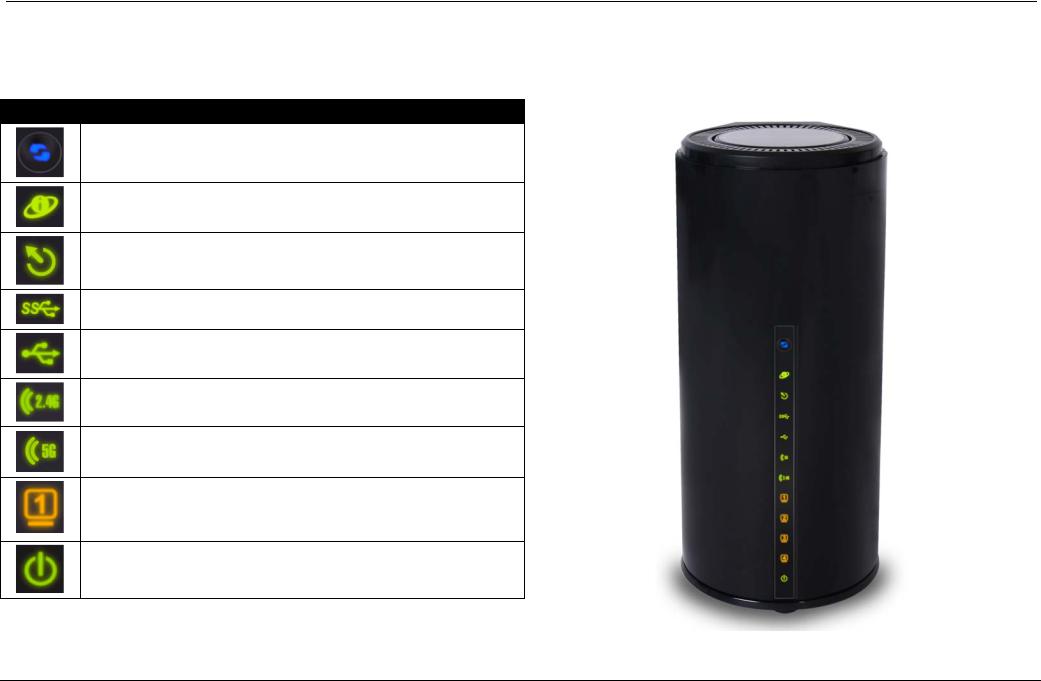
Dual Band AC1750 Gigabit ADSL2+ Modem Router User Manual
Hardware Overview
Front Panel
Number Description
WPS - The light will flash while a WPS connection is being established. The light will light solid for 5 seconds if a successful WPS connection has been made. This is also the WPS button used to initiate the push-button WPS connection.
Internet - Steady green light indicates a successful Internet connection. Steady red light indicates failed Internet connection. Dark if no WAN protocol is configured.
DSL - Steady green light indicates a valid ADSL connection. This will light after the ADSL negotiation process has been settled. A blinking green light indicates activity on the WAN (ADSL) interface.
USB 3.0 - Steady green light indicates a successful USB connection. Dark if no
USB device is connected.
USB 2.0 - Steady green light indicates a successful USB connection. Dark if no
USB device is connected.
2.4GHz WLAN - Steady green light indicates the 2.4GHz WLAN is available.
5GHz WLAN - Steady green light indicates the 5GHz WLAN is available.
LAN - A solid light indicates a valid link on startup. This light will blink when there is activity currently passing through the Ethernet port. A green light will be illuminated for a 10/100Mbps connection and an amber light will be illuminated for a 1000Mbps connection.
Power - A steady green light indicates the unit is powered on. When the device is powered off this remains dark. During the Power-On Self-Test this light will be red. If this light remains red after the POST, a malfunction has occurred.
Product Overview |
Page 5 |
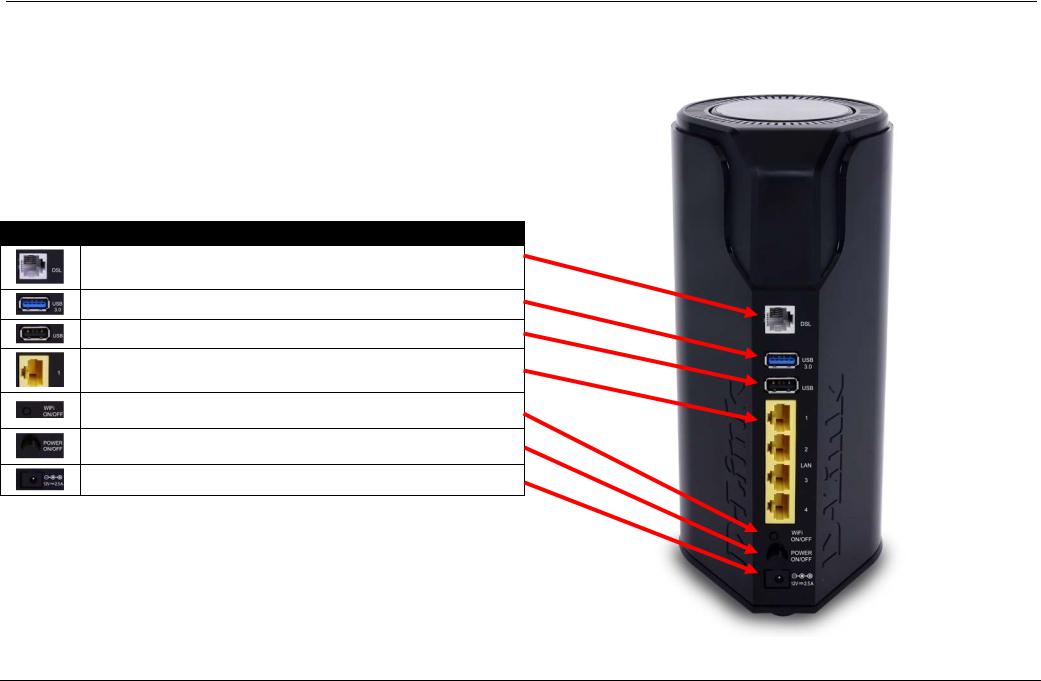
Dual Band AC1750 Gigabit ADSL2+ Modem Router User Manual
Rear Panel
Number Description
ADSL Port - Use the DSL cable to connect to your telephone line (RJ-11 port).
USB (3.0) Port - Use the USB 3.0 port to connect your USB 3.0 device.
USB (2.0) Port - Use the USB 2.0 port to connect your USB 2.0 device.
Ethernet Ports - Use the Ethernet ports to connect the router to your Ethernet
LAN or Ethernet devices.
Wireless On/Off Switch Button - Please press and hold on for 3 seconds to turn on/turn off.
Power Button - Push in to power-on the router. Push again to power-off the router.
Power Receptor - Receptor for the supplied power adapter.
Product Overview |
Page 6 |
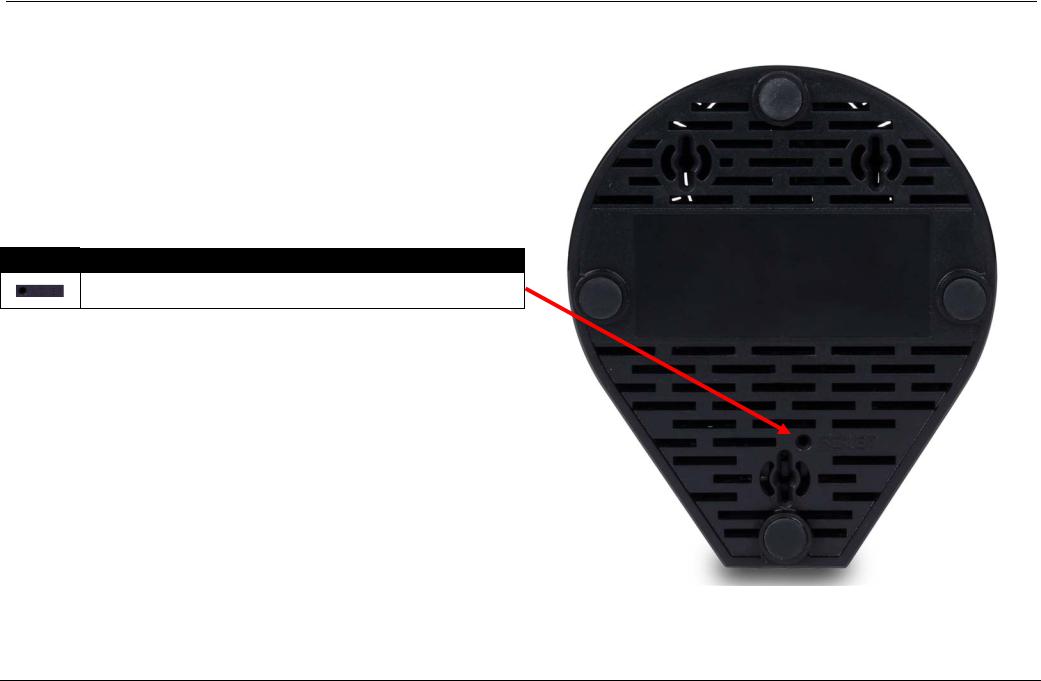
Dual Band AC1750 Gigabit ADSL2+ Modem Router User Manual
Bottom Panel
Number Description
Reset Button - Press and hold the button for 10-15 seconds to restore the device to its original factory default settings.
Product Overview |
Page 7 |

Dual Band AC1750 Gigabit ADSL2+ Modem Router User Manual
Basic Installation
This section will walk you through the installation process. Placement of the router is very important. Do not place the router in an enclosed area such as a closet, cabinet, or in the attic or garage.
Before You Begin
Please read and make sure you understand all the prerequisites for proper installation of your new router. Have all the necessary information and equipment on hand before beginning the installation.
Installation Notes
In order to establish a connection to the Internet it will be necessary to provide information to the router that will be stored in its memory. For some users, only their account information (Username and Password) is required. For others, various parameters that control and define the Internet connection will be required.
Low Pass Filters
Since ADSL and telephone services share the same copper wiring to carry their respective signals, a filtering mechanism may be necessary to avoid mutual interference. A low pass filter device can be installed for each telephone that shares the line with the ADSL line. These filters are easy to install passive devices that connect to the ADSL device and/or telephone using standard telephone cable. Ask your service provider for more information about the use of low pass filters with your installation.
Operating Systems
The router uses an HTML-based web interface for setup and management. The Web configuration manager may be accessed using any operating system capable of running web browser software, including Windows®, Macintosh, and Linux-based Operating Systems.
Web Browser
Any common Web browser can be used to configure the router using the Web configuration management software. The program is designed to work best with more recently released browsers such as Internet Explorer 7 or higher, Firefox 3.5 or higher, Safari 4 or higher, or Chrome 8 or higher.. The Web browser must have JavaScript enabled. JavaScript is enabled by default on many browsers. Make sure JavaScript has not been disabled by other software (such as virus protection or web user security packages) that may be running on your computer.
Ethernet Port (NIC Adapter)
Any computer that uses the router must be able to connect to it through one of the Ethernet ports on the router. This connection is an Ethernet connection and therefore requires that your computer be equipped with an Ethernet port as well. Most notebook computers are now sold with an Ethernet port already installed. Likewise, most fully assembled desktop computers come with an Ethernet adapter as standard equipment. If your computer does not have an Ethernet port, you must install an Ethernet NIC adapter before you can use the router. If you must install an adapter, follow the installation instructions that come with the Ethernet NIC adapter.
Basic Installation |
Page 8 |

Dual Band AC1750 Gigabit ADSL2+ Modem Router User Manual
Additional Software
It may be necessary to install software on your computer that enables the computer to access the Internet. Additional software must be installed if you are using the device a simple bridge. For a bridged connection, the information needed to make and maintain the Internet connection is stored on another computer or gateway device, not in the router itself.
If your ADSL service is delivered through a PPPoE connection, the information needed to establish and maintain the Internet connection can be stored in the router. In this case, it is not necessary to install software on your computer. It may however be necessary to change some settings in the device, including account information used to identify and verify the connection.
All connections to the Internet require a unique global IP address. For bridged connections, the global IP settings must reside in a TCP/IP enabled device on the LAN side of the bridge, such as a PC, a server, a gateway device such as a router or similar firewall hardware. The IP address can be assigned in a number of ways. Your network service provider will give you instructions about any additional connection software or NIC configuration that may be required.
Basic Installation |
Page 9 |

Dual Band AC1750 Gigabit ADSL2+ Modem Router User Manual
Information needed from ADSL service provider
Username
This is the Username used to log on to your ADSL service provider’s network. Your ADSL service provider uses this to identify your account.
Password
This is the Password used, in conjunction with the Username above, to log on to your ADSL service provider’s network. This is used to verify the identity of your account.
WAN Setting / Connection Type
These settings describe the method your ADSL service provider uses to transport data between the Internet and your computer. Most users will use the default settings. You may need to specify one of the following WAN Setting and Connection Type configurations (Connection Type settings listed in parenthesis):
•Static IP Address (1483 Routed IP LLC or 1483 Routed IP VC-Mux)
•DHCP (1483 Routed IP LLC or 1483 Routed IP VC-Mux)
•PPPoE (PPPoE LLC or PPPoE VC-Mux)
•PPPoA (PPPoA LLC or PPPoA VC-Mux)
•Bridge Mode (1483 Bridged IP LLC or 1483 Bridged IP VC Mux)
Modulation Type
ADSL uses various standardized modulation techniques to transmit data over the allotted signal frequencies. Some users may need to change the type of modulation used for their service. The default DSL modulation (Autosense) used for the router automatically detects all types of ADSL, ADSL2, and ADSL2+ modulation.
Security Protocol
This is the method your ADSL service provider will use to verify your Username and Password when you log on to their network. Your router supports the PAP and CHAP protocols.
VPI
Most users will not be required to change this setting. The Virtual Path Identifier (VPI) is used in conjunction with the Virtual Channel Identifier (VCI) to identify the data path between your ADSL service provider’s network and your computer. If you are setting up the router for multiple virtual connections, you will need to configure the VPI and VCI as instructed by your ADSL service provider for the additional connections. This setting can be changed in the WAN Settings window of the web management interface.
VCI
Most users will not be required to change this setting. The Virtual Channel Identifier (VCI) used in conjunction with the VPI to identify the data path between your ADSL service provider’s network and your computer. If you are setting up the router for multiple virtual connections, you will need to configure the VPI and VCI as instructed by your ADSL service provider for the additional connections. This setting can be changed in the WAN Settings window of the web management interface.
Basic Installation |
Page 10 |

Dual Band AC1750 Gigabit ADSL2+ Modem Router User Manual
Information needed about this Router
Username
This is the Username needed access the router’s web management interface. When you attempt to connect to the device through a web browser you will be prompted to enter this Username. The default Username for the router is “admin”.
Password
This is the Password you will be prompted to enter when you access the router’s web management interface. The default Password is “admin”.
LAN IP Addresses for the Router
This is the IP address you will enter into the Address field of your web browser to access the router’s configuration Graphical User Interface (GUI) using a web browser. The default IP address is 192.168.1.1. This may be changed to suit any IP address scheme the user desires. This address will be the base IP address used for DHCP service on the LAN when DHCP is enabled.
LAN Subnet Mask for the Router
This is the subnet mask used by the router, and will be used throughout your LAN. The default subnet mask is 255.255.255.0. This can be changed later.
Information needed about your LAN or computer
Ethernet NIC
If your computer has an Ethernet NIC, you can connect the router to this Ethernet port using an Ethernet cable. You can also use the Ethernet ports on the router to connect to other computer or Ethernet devices.
DHCP Client status
Your ADSL router is configured, by default, to be a DHCP server. This means that it can assign an IP address, subnet mask, and a default gateway address to computers on your LAN. The default range of IP addresses the router will assign are from 192.168.1.2 to 192.168.1.254. Your computer (or computers) needs to be configured to obtain an IP address automatically (that is, they need to be configured as DHCP clients.)
Once you have the above information, you are ready to setup and configure your ADSL router.
Basic Installation |
Page 11 |

Dual Band AC1750 Gigabit ADSL2+ Modem Router User Manual
Device Installation
The router connects two separate physical interfaces, an ADSL (WAN) and an Ethernet (LAN) interface. Place the router in a location where it can be connected to the various devices as well as to a power source. The router should not be located where it will be exposed to moisture or excessive heat. Make sure the cables and power cord are placed safely out of the way so they do not create a tripping hazard. As with any electrical appliance, observe common sense safety procedures.
The router can be placed on a shelf or desktop, ideally you should be able to see the LED indicators on the front if you need to view them for troubleshooting.
Power on Router
The router must be used with the power adapter included with the device.
1.Insert the AC Power Adapter cord into the power receptacle located on the rear panel of the router and plug the adapter into a suitable nearby power source.
2.Press the Power button into the on position. You should see the Power LED indicator light up and remain lit.
3.If the Ethernet port is connected to a working device, check the Ethernet LED indicators to make sure the connection is valid. The router will attempt to establish the ADSL connection, if the ADSL line is connected and the router is properly configured this should light up after several seconds. If this is the first time installing the device, some settings may need to be changed before the router can establish a connection.
Factory Reset Button
The router may be reset to the original factory default settings by using a ballpoint pen or paperclip to gently push down the reset button in the following sequence:
1.Press and hold the reset button while the device is powered on for 10-15 seconds.
2.Release the reset button.
Remember that this will wipe out any settings stored in flash memory including user account information and LAN IP settings. The device settings will be restored to the factory default IP address 192.168.1.1 and the subnet mask is 255.255.255.0. The default management username is “admin” and the default password is “admin”.
Basic Installation |
Page 12 |

Dual Band AC1750 Gigabit ADSL2+ Modem Router User Manual
Network Connections
Connect ADSL Line
Use the ADSL cable included with the router to connect it to a telephone wall socket or receptacle. Plug one end of the cable into the ADSL port (RJ-11 receptacle) on the rear panel of the router and insert the other end into the RJ-11 wall socket. If you are using a low pass filter device, follow the instructions included with the device or given to you by your service provider. The ADSL connection represents the WAN interface, the connection to the Internet. It is the physical link to the service provider’s network backbone and ultimately to the Internet.
Connect Router to Ethernet
The router may be connected to a single computer or Ethernet device through the Ethernet ports on the rear panel. Any connection to an Ethernet concentrating device such as a switch or hub must operate at a speed of 10/100/1000Mbps. When connecting the router to any Ethernet device that is capable of operating at speeds higher than 10Mbps, be sure that the device has auto-negotiation (NWay) enabled for the connecting port. Use standard twisted-pair cable with RJ-45 connectors. The RJ-45 ports on the router are a crossed port (MDI-X). Follow standard Ethernet guidelines when deciding what type of cable to use to make this connection. When connecting the router directly to a PC or server use a normal straight-through cable. You should use a crossed cable when connecting the router to a normal (MDI-X) port on a switch or hub. Use a normal straight-through cable when connecting it to an uplink (MDI-II) port on a hub or switch. The rules governing Ethernet cable lengths apply to the LAN to router connection. Be sure that the cable connecting the LAN to the router does not exceed 100 meters.
Hub or Switch to Router Connection
Connect the router to an uplink port (MDI-II) on an Ethernet hub or switch with a straight-through cable. If you wish to reserve the uplink port on the switch or hub for another device, connect to any on the other MDI-X ports (1x, 2x, etc.) with a crossed cable.
Computer to Router Connection
You can connect the router directly to an Ethernet adapter card (NIC) installed on a PC using the Ethernet cable provided.
Basic Installation |
Page 13 |
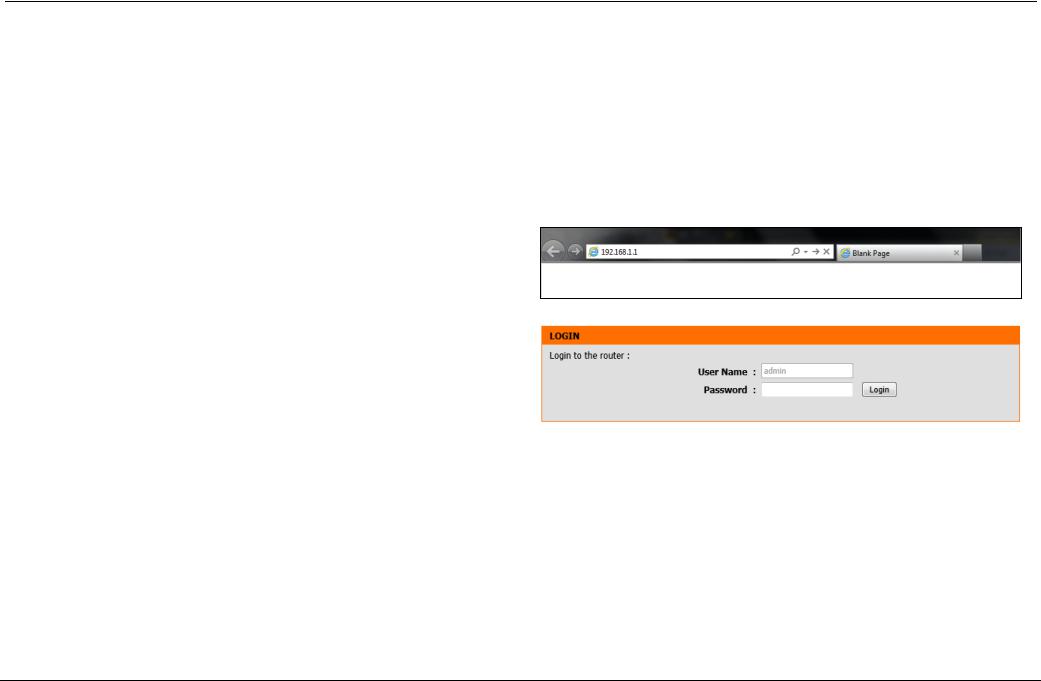
Dual Band AC1750 Gigabit ADSL2+ Modem Router User Manual
Getting Started
This section will show you how to set up and configure your new D-Link router using the Web-based configuration utility.
How to connect to the Web User Interface
Connect to the Router
To configure the WAN connection used by the router it is first necessary to communicate with the router through its management interface, which is HTML-based and can be accessed using a web browser. The easiest way to make sure your computer has the correct IP settings is to configure it to use the DHCP server in the router.
To access the web user interface, open a web-browser such as Internet Explorer and enter the IP address of the router (192.168.1.1) into the address bar and press the Enter key on your keyboard.
The User Name field will display “admin”. Enter “admin” in the Password field and click the Login button to proceed. If you get a Page Cannot be Displayed error, please refer to the Troubleshooting section for assistance.
Basic Installation |
Page 14 |
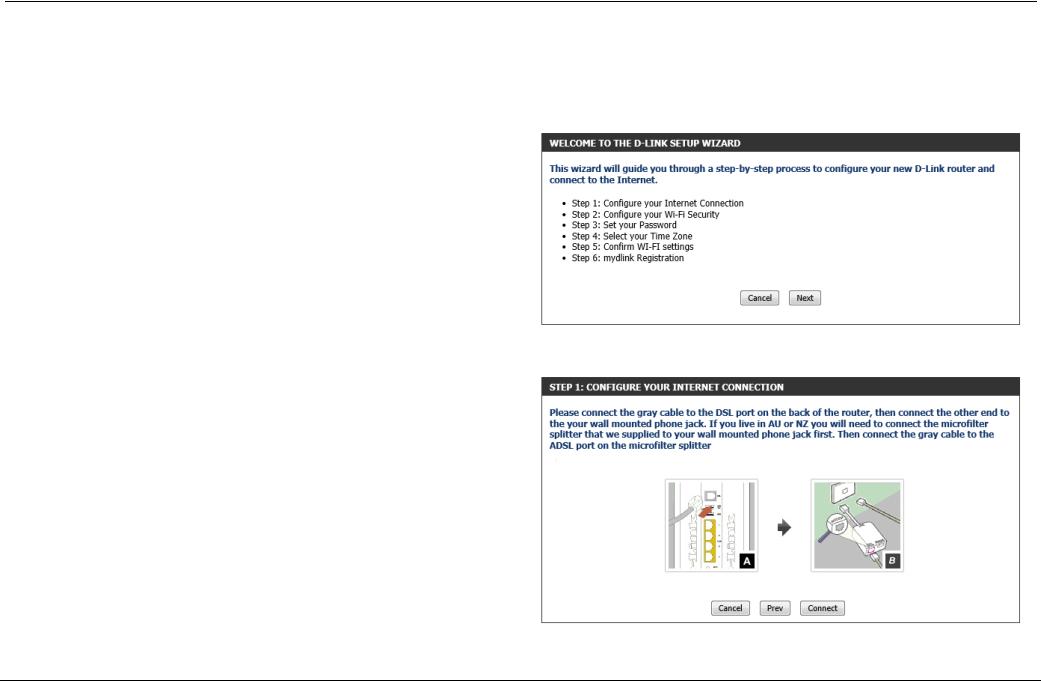
Dual Band AC1750 Gigabit ADSL2+ Modem Router User Manual
First Time Installation
The D-Link Setup Wizard will be initiated when a user logs into the router’s Web User Interface (Web UI) for the first time. It is designed to assist users with an easy step-by- step installation procedure, configuring the basic features found on this router.
Welcome to the D-Link Setup Wizard
On this page, we can read through the steps that will be used for this wizard.
Click the Next button to continue to the next step.
Click the Cancel button to discard the changes made and return to the main menu.
Step 1: Configure Your Internet Connection
Connect the one end of the Internet telephone cable (RJ-11) into the Internet port of the router and make sure the other end is connected to the DSL connection point.
Click the Connect button to initiate the Internet connection test.
Click the Prev button to return to the previous step.
Click the Cancel button to discard the changes made and return to the main menu.
Basic Installation |
Page 15 |
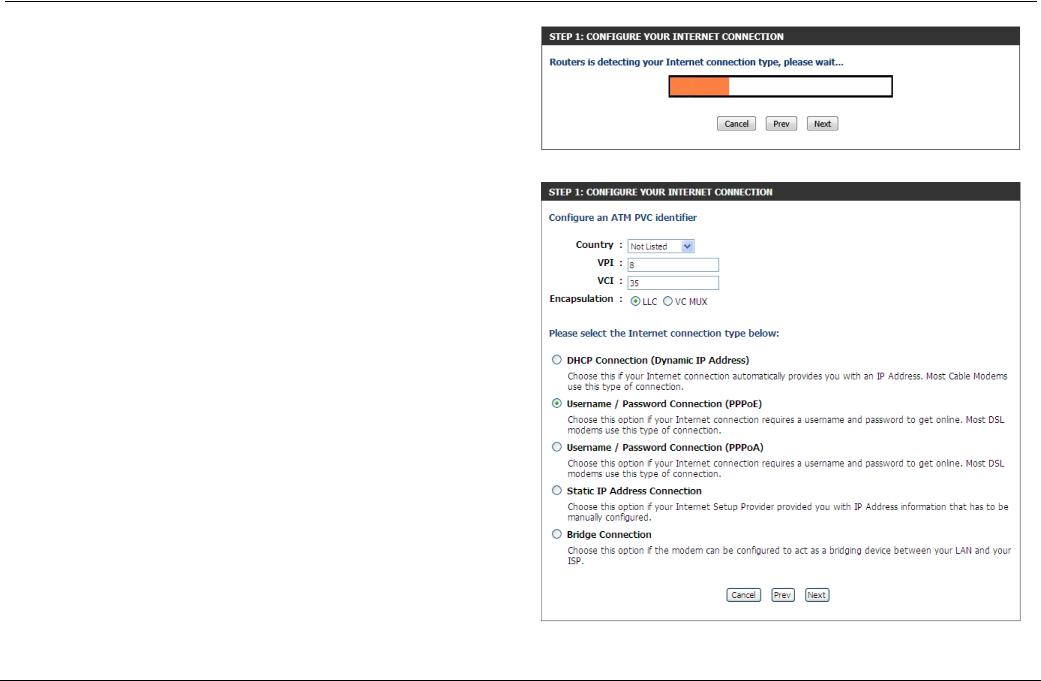
Dual Band AC1750 Gigabit ADSL2+ Modem Router User Manual
On this page, the router is testing the Internet connectivity from the DSL provider.
Click the Next button to continue to the next step.
Click the Prev button to return to the previous step.
Click the Cancel button to discard the changes made and return to the main menu.
After the DSL synchronization test has passed, we can select an Internet connection type from the list provided. In this section, we can configure the following:
Country: Select your country from the drop-down menu. After selecting your country from the drop-down menu, the VPI and VCI parameters will automatically be selected for your country.
VPI: Enter the Virtual Path Identifier (VPI) value here. VCI: Enter the Virtual Circuit Identifier (VCI) value here.
Encapsulation: Select the encapsulation method here. Options to choose from are
LLC and VC MUX.
DHCP Connection (Dynamic IP Address): Select this option when your Internet connection can be made automatically. When selecting this option, this wizard will automatically continue to step 2.
Username / Password Connection (PPPoE): Select this option when your Internet connection requires a username and a password. For DSL connections, use this option.
Username / Password Connection (PPPoA): Select this option when your Internet connection requires a PPPoA username and password.
Static IP Address Connection: Select this option when your Internet connection requires an IP address, Default Gateway IP address, and DNS IP addresses.
Bridge Connection: Select this option to use this device as a bridging device between your LAN and the ISP. When selecting this option, this wizard will automatically continue to step 2.
Click the Next button to continue to the next step.
Click the Prev button to return to the previous step.
Click the Cancel button to discard the changes made and return to the main menu.
Basic Installation |
Page 16 |
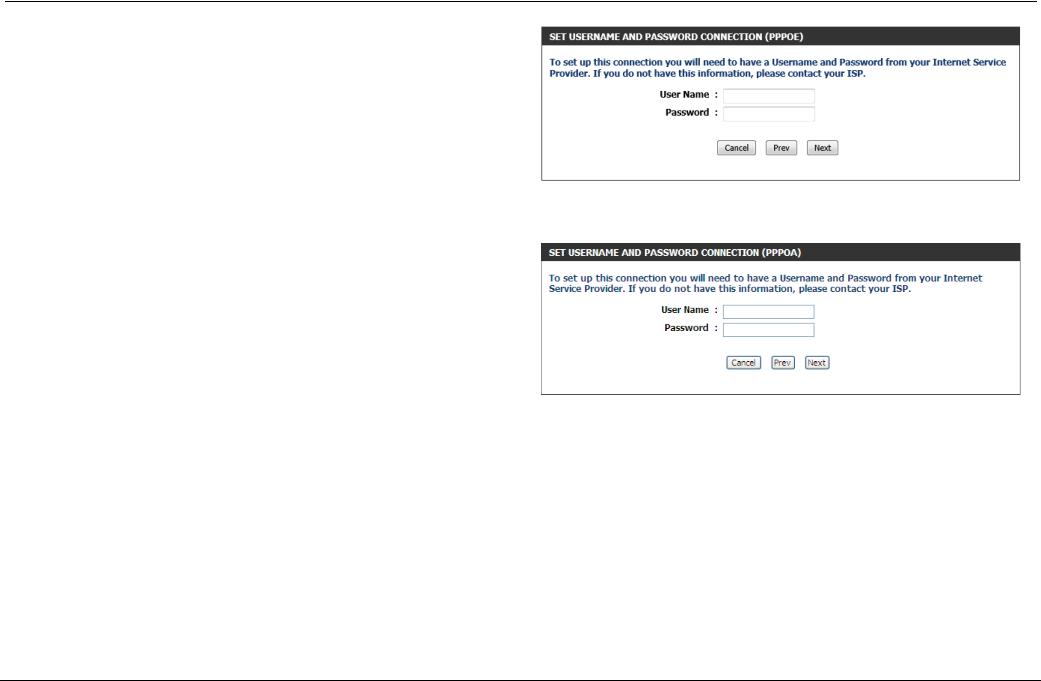
Dual Band AC1750 Gigabit ADSL2+ Modem Router User Manual
After selecting to use the Username/Password Connection (PPPoE), the following page will be available. In this section, we can configure the following:
User Name: Enter the PPPoE username here. Password: Enter the PPPoE password here.
Note: This information is usually supplied by the Internet Service Provider (ISP).
Click the Next button to continue to the next step.
Click the Prev button to return to the previous step.
Click the Cancel button to discard the changes made and return to the main menu.
After selecting to use the Username/Password Connection (PPPoA), the following page will be available. In this section, we can configure the following:
User Name: Enter the PPPoA username here. Password: Enter the PPPoA password here.
Note: This information is usually supplied by the Internet Service Provider (ISP).
Click the Next button to continue to the next step.
Click the Prev button to return to the previous step.
Click the Cancel button to discard the changes made and return to the main menu.
Basic Installation |
Page 17 |
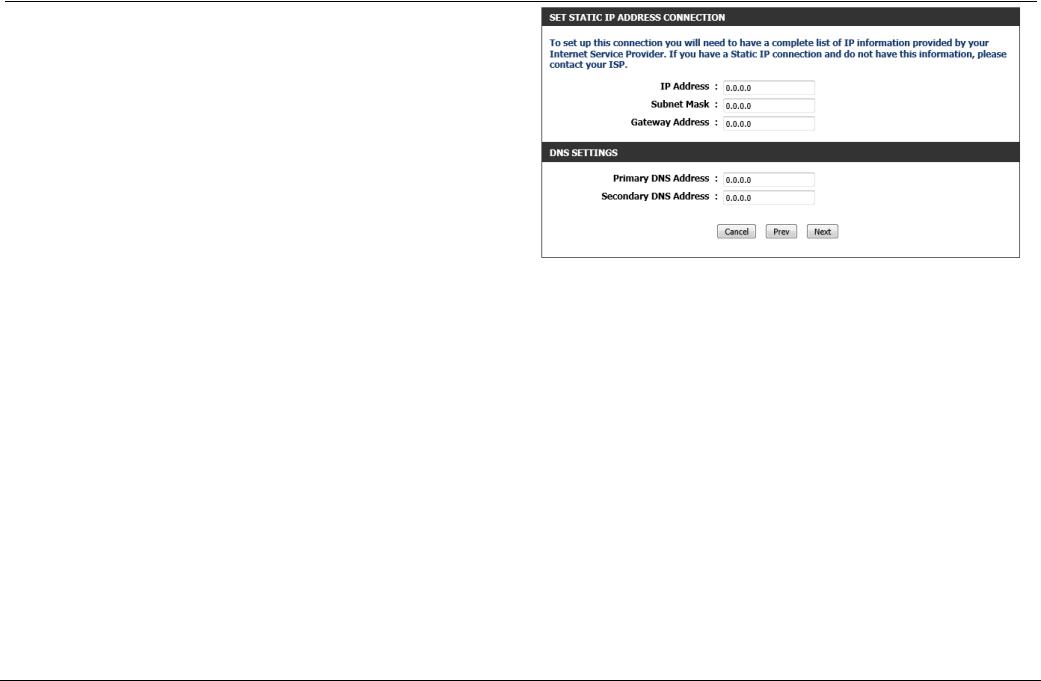
Dual Band AC1750 Gigabit ADSL2+ Modem Router User Manual
After selecting to use the Static IP Address Connection, the following page will be available. In this section, we can configure the following:
IP Address: Enter the WAN static IP address here. Subnet Mask: Enter the WAN subnet mask here.
Gateway Address: Enter the WAN gateway IP address here. Primary DNS Address: Enter the primary DNS IP address here.
Secondary DNS Address: Enter the secondary DNS IP address here. This field is optional.
Note: This information is usually supplied by the ISP.
Click the Next button to continue to the next step.
Click the Prev button to return to the previous step.
Click the Cancel button to discard the changes made and return to the main menu.
Basic Installation |
Page 18 |
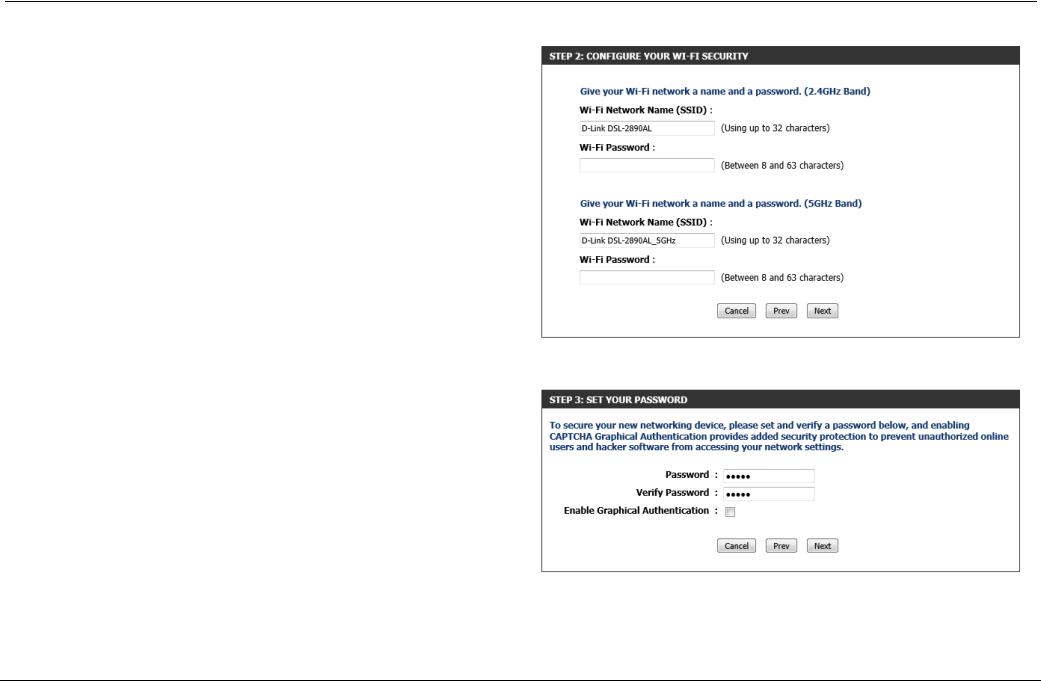
Dual Band AC1750 Gigabit ADSL2+ Modem Router User Manual
Step 2: Configure Your Wi-Fi Security
After configuring the Internet connection, we can configure the wireless connectivity used on this router. In this section, we can configure the following:
Wi-Fi Network Name: Enter the wireless network name (SSID) here. Remember to use separate SSIDs for the 2.4GHz and 5GHz connections, to prevent confusion. These SSIDs are used by wireless clients to connect to this router. When wireless clients scan for available wireless networks, these names will appear.
Wi-Fi Password: Enter the wireless password here. By default, the wireless security method used is WPA/WPA2-Personal with both TKIP and AES cipher types. When wireless clients connect to your wireless network, this password needs to be entered for a successful connection.
Click the Next button to continue to the next step.
Click the Prev button to return to the previous step.
Click the Cancel button to discard the changes made and return to the main menu.
Step 3: Set Your Password
After configuring the wireless connectivity, we can configure the Web UI login password for his router. In this section, we can configure the following:
Password: Enter the new Web UI login password here.
Verify Password: Enter the new Web UI login password here again.
Enable Graphical Authentication: Tick this option to enable the graphical authentication method. This is optional added security.
Note: For security, it is highly recommended to change the default login password for this router. The username cannot be changed.
Click the Next button to continue to the next step.
Click the Prev button to return to the previous step.
Click the Cancel button to discard the changes made and return to the main menu.
Basic Installation |
Page 19 |

Dual Band AC1750 Gigabit ADSL2+ Modem Router User Manual
Step 4: Select Your Time Zone
After configuring the Web UI login details, we can configure the time zone used by this router. In this section, we can configure the following:
Time Zone: Select the time zone that should be used by this router. This will be used by the time and date configuration later on in this manual.
Click the Next button to continue to the next step.
Click the Prev button to return to the previous step.
Click the Cancel button to discard the changes made and return to the main menu.
Step 5: Confirm Wi-Fi Settings
After configuring the time zone, we can view a summary of the Wi-Fi settings for confirmation.
Click the Next button to continue to the next step.
Click the Prev button to return to the previous step.
Click the Cancel button to discard the changes made and return to the main menu.
After clicking the Next button, the settings will be saved and Internet connectivity will be attempted.
After this, the D-Link Setup Wizard will be completed and the user will be navigated to the main Web UI page.
When the Internet connection is ready, the router will proceed to the mydlink™ registration in step 6. When the Internet connection is not ready, a pop-up window will be displayed to remind the user to restart or quit the Setup Wizard.
Basic Installation |
Page 20 |

Dual Band AC1750 Gigabit ADSL2+ Modem Router User Manual
If no Internet connection was detected, the user can restart the D-Link Setup Wizard or be navigated to the main Web UI page.
Click the OK button to restart the D-Link Setup Wizard.
Click the Cancel button to navigate to the main Web UI page.
Step 6: mydlink Registration
If the Internet connection was successfully detected, the following page will be available. Please refer to mydlink™ Settings on page 94 for more information.
After this, the D-Link Setup Wizard will be completed and the user will be navigated to the main Web UI page.
Basic Installation |
Page 21 |
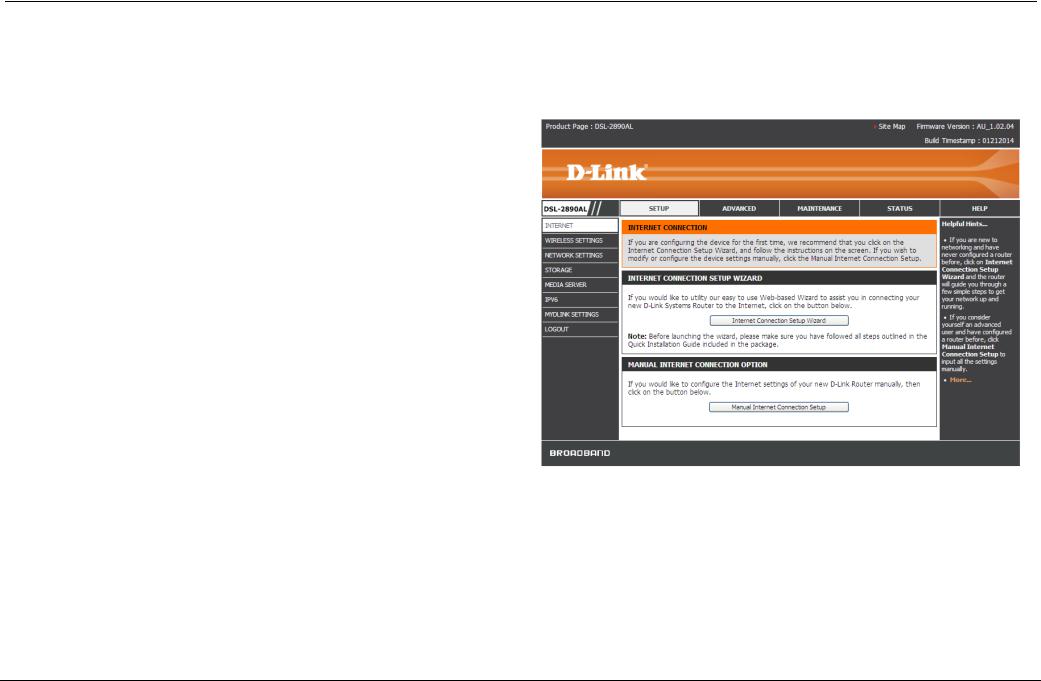
Dual Band AC1750 Gigabit ADSL2+ Modem Router User Manual
Web User Interface Configuration
After successfully logging into the Web User Interface, the following page will be displayed. This page is divided into clickable components that make the configuration of this device easier and more understandable.
The top menu lists out the Categories available for configuration. The categories available to configure on this device are Setup, Advanced, Maintenance, Status and Help.
The left menu lists out the Pages available, for each individual category, for configuration. In this example, we observe the pages available in the Setup category. The pages available here are Internet, Wireless Settings, Network Settings, Storage, Media Server, IPv6, and mydlink™ Settings.
Web User Interface Configuration |
Page 22 |
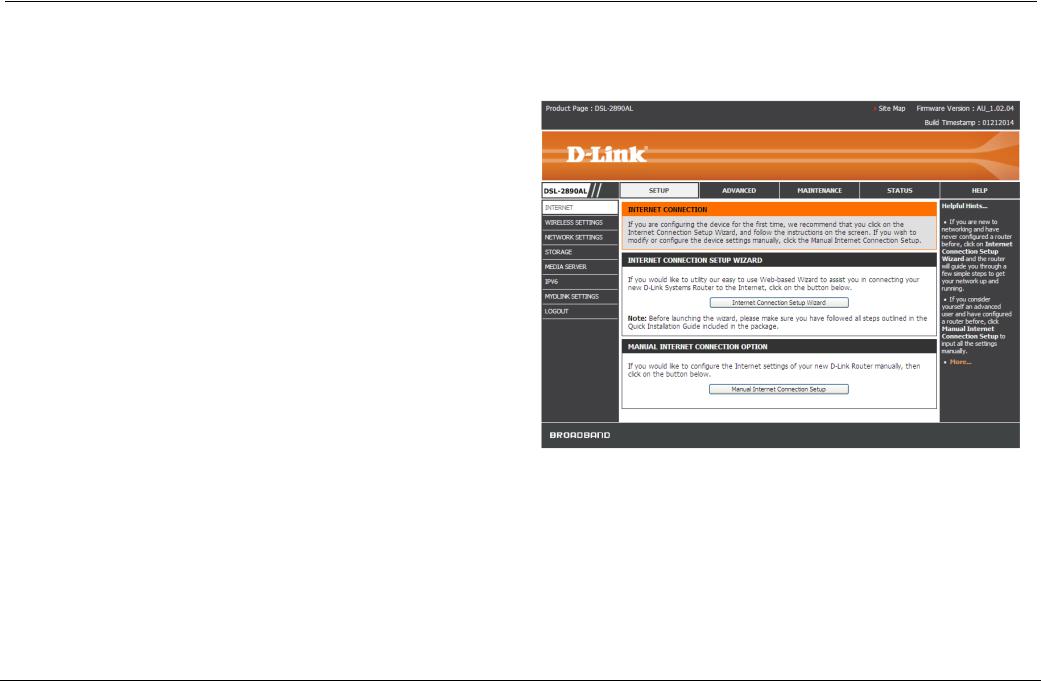
Dual Band AC1750 Gigabit ADSL2+ Modem Router User Manual
Setup Category
The Setup category is designed to assist the user with essential configurations, concerning the initial setup of this product.
The following pages can be found in the Setup category:
•Internet - On this page we can configure services related to the Internet connectivity of this product.
•Wireless Settings - On this page we can configure services related to the Wireless connectivity of this product.
•Network Settings - On this page we can configure services related to the Local Area Network connectivity of this product.
•Storage - On this page we can configure services related to the storage media and services used by this product.
•Media Server - On this page we can configure the DLNA media server and iTunes server used by this product.
•IPv6 - On this page we can configure services related to the IPv6 connectivity of this product.
•mydlink™ Settings - On this page we can configure the mydlink™ settings used by this product.
Web User Interface Configuration |
Page 23 |
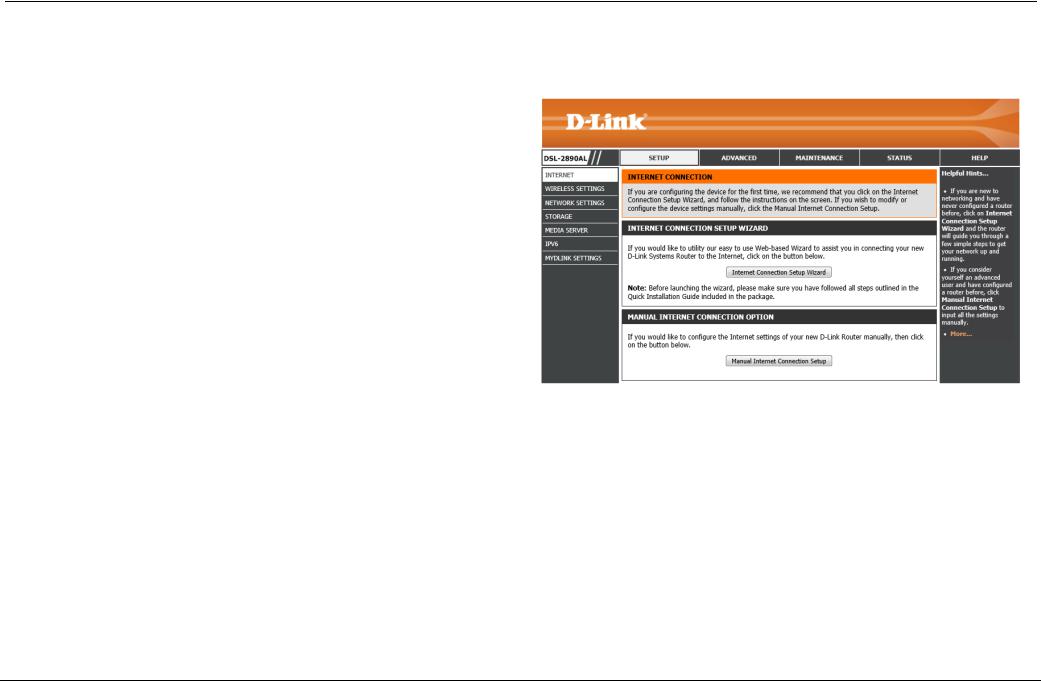
Dual Band AC1750 Gigabit ADSL2+ Modem Router User Manual
Internet
To access the Internet page, click on the Setup menu link, at the top, and then click on the Internet menu link, on the left.
On this page we can configure services related to the Internet connectivity of this product.
Web User Interface Configuration |
Page 24 |
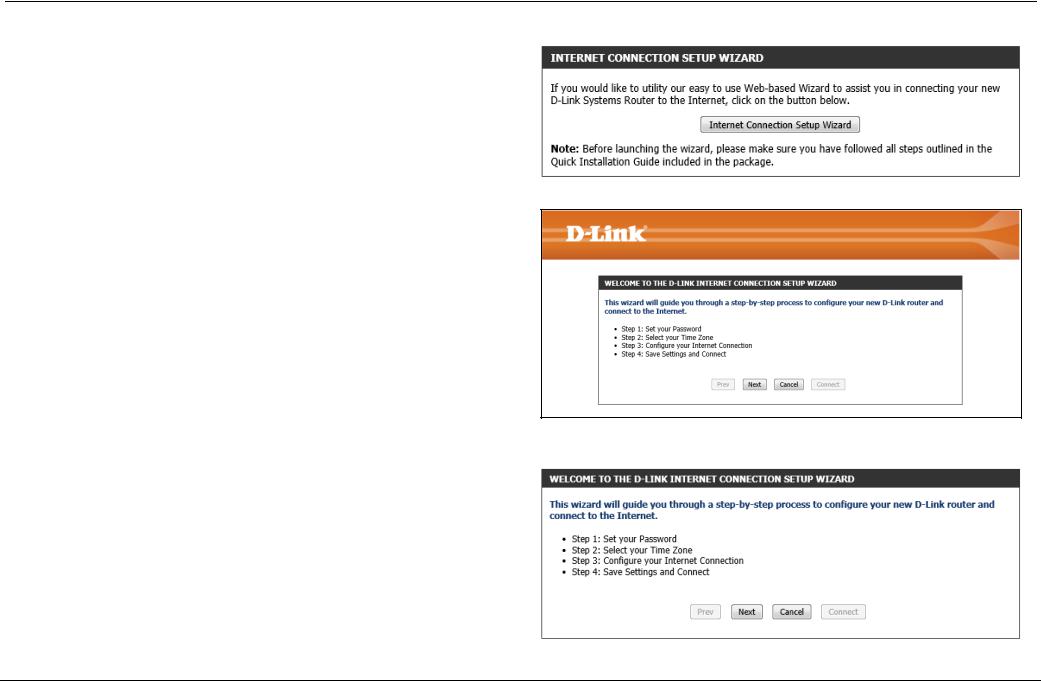
Dual Band AC1750 Gigabit ADSL2+ Modem Router User Manual
Internet Connection Setup Wizard
Click the Internet Connection Setup Wizard button to initiate the Internet connection setup wizard.
After clicking the Internet Connection Setup Wizard button, the following page will be available.
Welcome to the D-Link Internet Connection Setup Wizard
This wizard will guide user through a step-by-step wizard, divided into 4 steps, to configure the Internet connectivity used by this router.
Click the Next button to continue to the next page.
Click the Cancel button to discard the changes made and return to the main page.
Web User Interface Configuration |
Page 25 |
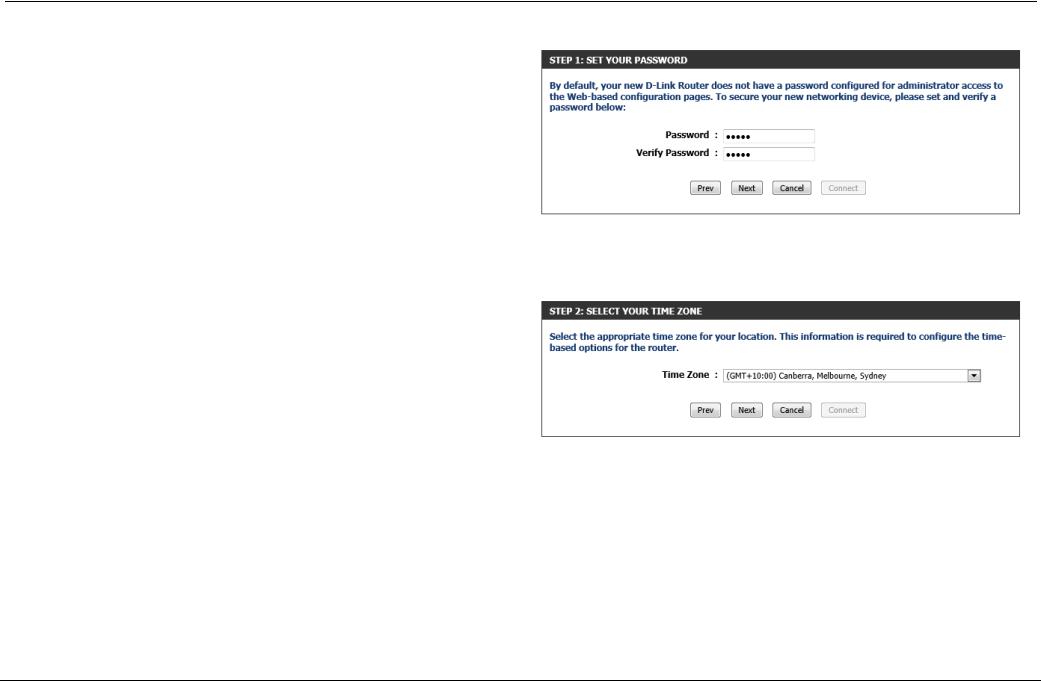
Dual Band AC1750 Gigabit ADSL2+ Modem Router User Manual
Step 1: Set Your Password
On this page we can configure the Web UI login password for his router. In this section, we can configure the following:
Password: Enter the new Web UI login password here.
Verify Password: Enter the new Web UI login password here again.
Note: For security, it is highly recommended to change the default login password for this router. The username cannot be changed.
Click the Next button to continue to the next step.
Click the Prev button to return to the previous step.
Click the Cancel button to discard the changes made and return to the main menu.
Step 2: Select Your Time Zone
After configuring the Web UI login details, we can configure the time zone used by this router. In this section, we can configure the following:
Time Zone: Select the time zone that should be used by this router. This will be used by the time and date configuration later on in this manual.
Click the Next button to continue to the next step.
Click the Prev button to return to the previous step.
Click the Cancel button to discard the changes made and return to the main menu.
Web User Interface Configuration |
Page 26 |
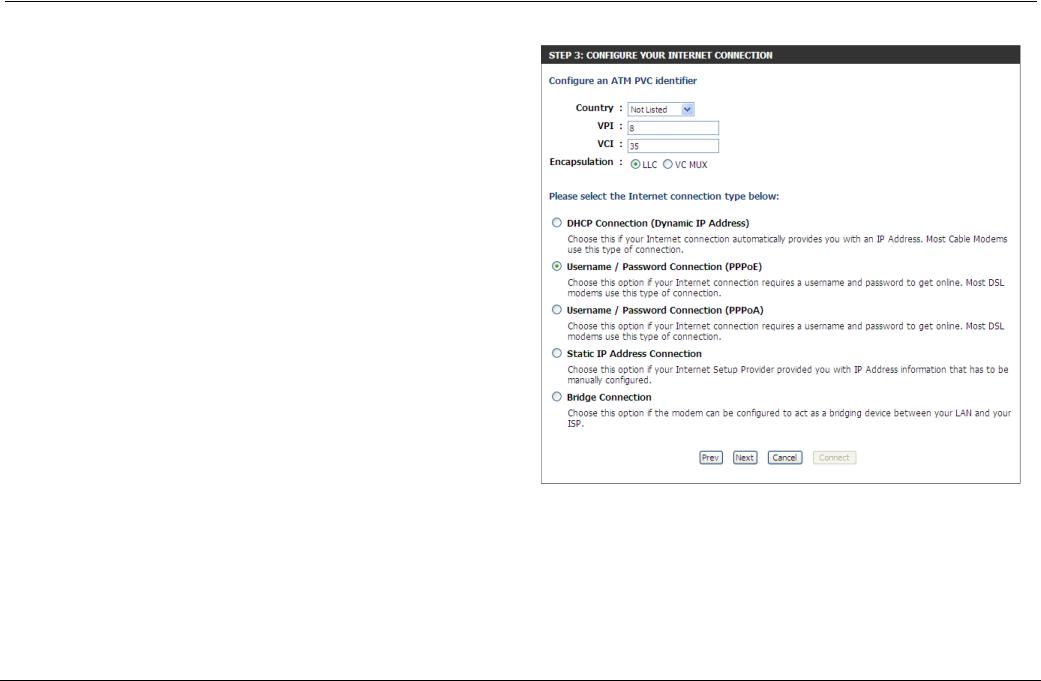
Dual Band AC1750 Gigabit ADSL2+ Modem Router User Manual
Step 3: Configure Your Internet Connection
After configuring the time zone, we can select an Internet connection type from the list provided. In this section, we can configure the following:
Country: Select your country from the drop-down menu. After selecting your country from the drop-down menu, the VPI and VCI parameters will automatically be selected for your country.
VPI: Enter the Virtual Path Identifier (VPI) value here. VCI: Enter the Virtual Circuit Identifier (VCI) value here.
DHCP Connection (Dynamic IP Address): Select this option when your Internet connection can be made automatically. When selecting this option, this wizard will automatically continue to step 2.
Username / Password Connection (PPPoE): Select this option when your Internet connection requires a username and a password. For DSL connections, use this option.
Username / Password Connection (PPPoA): Select this option when your Internet connection requires a PPPoA username and password.
Static IP Address Connection: Select this option when your Internet connection requires an IP address, Default Gateway IP address, and DNS IP addresses.
Bridge Connection: Select this option to use this device as a bridging device between your LAN and the ISP. When selecting this option, this wizard will automatically continue to step 2.
Click the Next button to continue to the next step.
Click the Prev button to return to the previous step.
Click the Cancel button to discard the changes made and return to the main menu.
Web User Interface Configuration |
Page 27 |
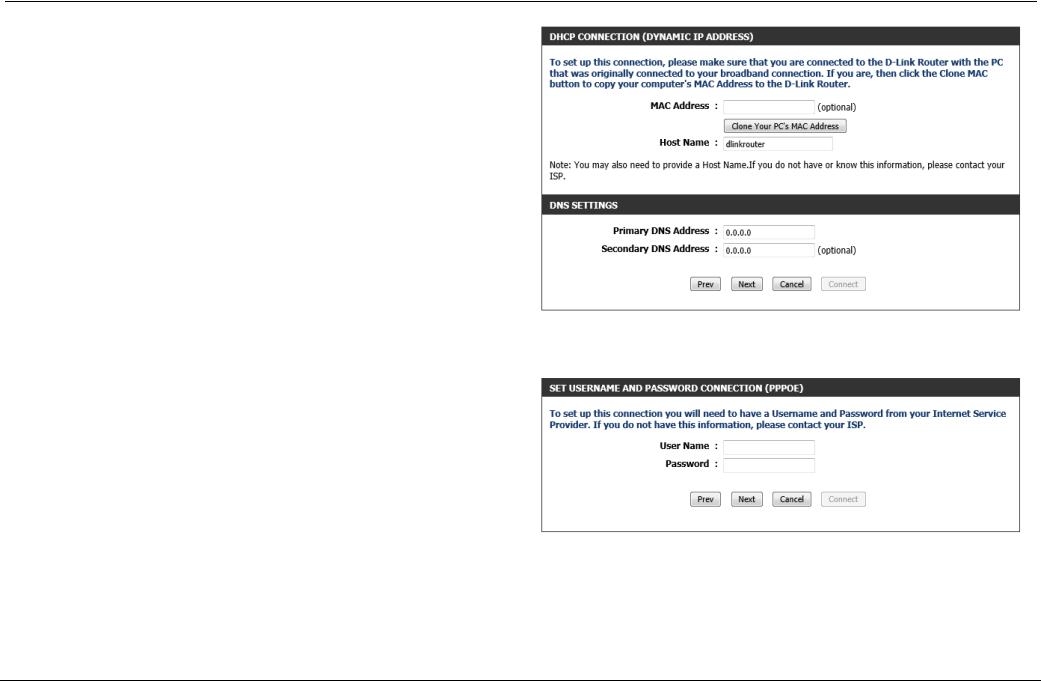
Dual Band AC1750 Gigabit ADSL2+ Modem Router User Manual
After selecting to use the DHCP Connection (Dynamic IP Address) connection method, the following page will be available. In this section, we can configure the following:
MAC Address: Enter the MAC address used for the Internet connection here. Alternatively, click the Clone Your PC’s MAC Address button to use the PC’s MAC address that was originally used to connect to the Internet before the purchase of this router.
Host Name: Enter the host name used for the Internet connection here. Primary DNS Address: Enter the primary DNS IP address here.
Secondary DNS Address: Enter the secondary DNS IP address here. This field is optional.
Note: This information is usually supplied by the ISP.
Click the Next button to continue to the next step.
Click the Prev button to return to the previous step.
Click the Cancel button to discard the changes made and return to the main menu.
After selecting to use the Username/Password Connection (PPPoE) connection method, the following page will be available. In this section, we can configure the following:
User Name: Enter the PPPoE username here. Password: Enter the PPPoE password here.
Note: This information is usually supplied by the Internet Service Provider (ISP).
Click the Next button to continue to the next step.
Click the Prev button to return to the previous step.
Click the Cancel button to discard the changes made and return to the main menu.
Web User Interface Configuration |
Page 28 |
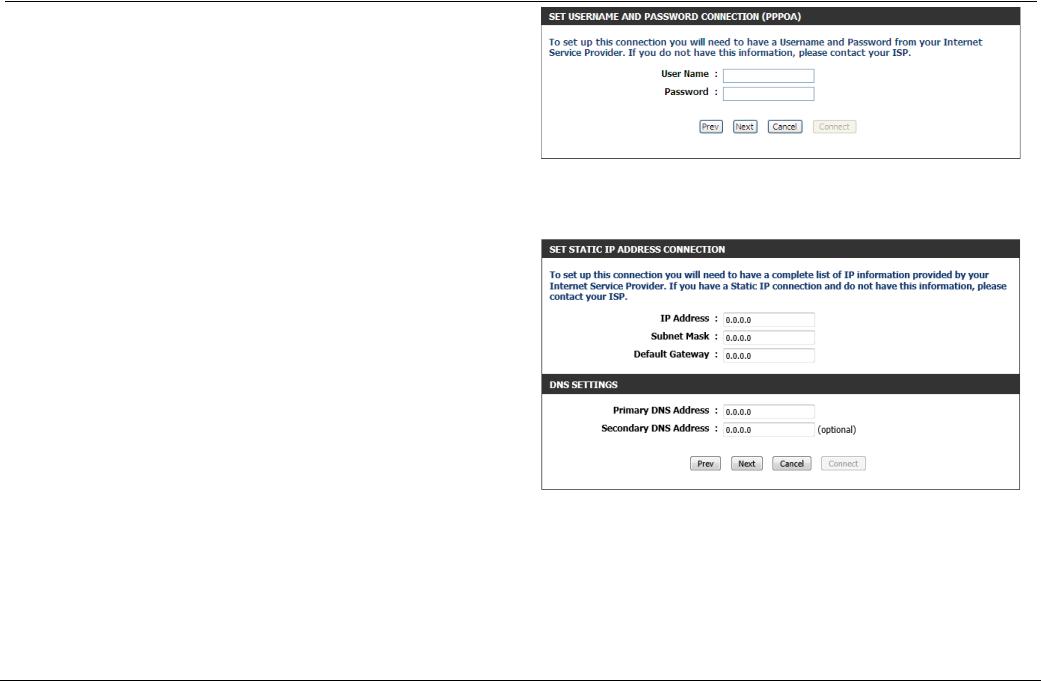
Dual Band AC1750 Gigabit ADSL2+ Modem Router User Manual
After selecting to use the Username/Password Connection (PPPoA) connection method, the following page will be available. In this section, we can configure the following:
User Name: Enter the PPPoA username here. Password: Enter the PPPoA password here.
Note: This information is usually supplied by the Internet Service Provider (ISP).
Click the Next button to continue to the next step.
Click the Prev button to return to the previous step.
Click the Cancel button to discard the changes made and return to the main menu.
After selecting to use the Static IP Address Connection method, the following page will be available. In this section, we can configure the following:
IP Address: Enter the WAN static IP address here. Subnet Mask: Enter the WAN subnet mask here.
Gateway Address: Enter the WAN gateway IP address here. Primary DNS Address: Enter the primary DNS IP address here.
Secondary DNS Address: Enter the secondary DNS IP address here. This field is optional.
Note: This information is usually supplied by the ISP.
Click the Next button to continue to the next step.
Click the Prev button to return to the previous step.
Click the Cancel button to discard the changes made and return to the main menu.
Web User Interface Configuration |
Page 29 |
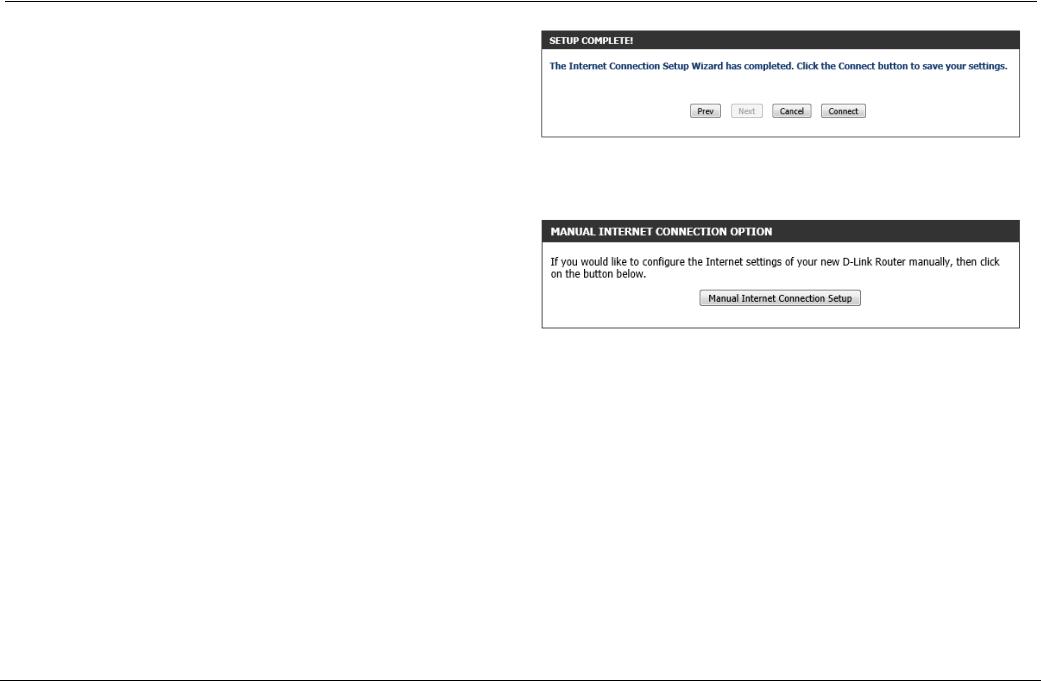
Dual Band AC1750 Gigabit ADSL2+ Modem Router User Manual
Setup Complete
After clicking the Next button, the following page will be available. On this page we can view a confirmation message, confirming that the D-Link Internet Connection Setup Wizard is completed.
Click the Connect button to initiate an attempt to connect to the Internet using the settings configured throughout this wizard.
Click the Prev button to return to the previous step.
Click the Cancel button to discard the changes made and return to the main menu.
Manual Internet Connection Option
Click the Manual Internet Connection Setup button to navigate to the Internet
Connection Setup page to manually configure the Internet Connection.
Web User Interface Configuration |
Page 30 |
